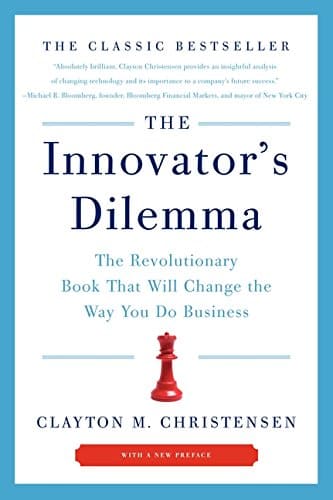The Innovator's Dilemma: The Revolutionary Book that Will Change the Way You Do Business
Clayton M. Christensen, L.J. Ganser · First published January 7th 2003

Harvard professor Clayton M. Christensen says outstanding companies can do everything right and still lose their market leadership — or worse, disappear completely. And he not only proves what he says, he tells others how to avoid a similar fate.
Focusing on “disruptive technology” — the Honda Super Cub, Intel’s 8088 processor, or the hydraulic excavator, for example — Christensen shows why most companies miss “the next great wave.” Whether in electronics or retailing, a successful company with established products will get pushed aside unless managers know when to abandon traditional business practices. Using the lessons of successes and failures from leading companies, “The Innovator’s Dilemma” presents a set of rules for capitalizing on the phenomenon of disruptive innovation.
Book Summary
“The Innovator’s Dilemma” is a book by Harvard Business School Professor Clayton Christensen, which explores the challenges faced by companies when they try to innovate in established markets. The book argues that well-established companies can struggle to innovate because of their focus on efficiency and their existing business models, which can stifle creativity and prevent new ideas from taking hold.
Key Takeaways
1. Successful companies can struggle to innovate: Established companies may find it challenging to innovate because of their focus on efficiency and existing business models.
2. Disruptive innovation is different from sustaining innovation: Disruptive innovations create new markets and disrupt established ones, whereas sustaining innovations improve existing products and processes.
3. Disruptive technologies often come from unexpected sources: Disruptive innovations can come from small, entrepreneurial companies rather than established market leaders.
4. Companies can miss disruptive innovations: Companies may miss disruptive innovations because they don’t recognize the potential of new technologies or market changes.
5. Companies must balance the needs of their existing customers with investment in new technologies: Companies must balance the needs of their existing customers with investment in new technologies to ensure they remain competitive.
6. The best response to disruptive innovation is not always to compete head-on: Companies can respond to disruptive innovations by creating new products or services, acquiring smaller companies, or partnering with other companies.
7. Companies should focus on creating a culture of innovation: Companies can foster a culture of innovation by encouraging experimentation, risk-taking, and creative thinking.
8. The role of leadership in innovation: Leaders play a crucial role in fostering a culture of innovation, as they set the tone for the organization and make key decisions about investment in new technologies.
9. Innovation requires a long-term perspective: Companies need to have a long-term perspective to succeed in innovation, as the development and commercialization of new technologies can take years.
10. Companies need to be prepared to change: Companies must be prepared to change and adapt to new technologies and market changes if they are to succeed in the long term.